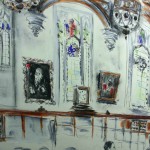Last week I was fortunate to attend a private view of Isobel Williams’ drawings from the UK Supreme Court, which are currently on display at Pinsent Masons LLP, near Liverpool Street. Followers of Williams’ work will know that she shares an alternative view from court. She does not offer the type of court sketches we’re used to, the sort drawn from memory and for the purposes of news reporting.
![low res PM copy[1]](http://clip.blogs.sas.ac.uk/files/2014/12/low-res-PM-copy1-300x197.jpg) Instead she captures the non newsworthy detail: an usher, a judge typing (pen in mouth), the portraits on display. The colours and style are unusual too. Her current exhibition includes outlines of barristers, the judges visible through their translucent figures. She reflects and describes on her blog, poetically:
Instead she captures the non newsworthy detail: an usher, a judge typing (pen in mouth), the portraits on display. The colours and style are unusual too. Her current exhibition includes outlines of barristers, the judges visible through their translucent figures. She reflects and describes on her blog, poetically:
People shifting on the leather-upholstered public benches make them creak like a sailing ship. A girl in front of me has long swishy hair. My pen and brush swish on the textured paper, in her ear. She doesn’t know she is hearing the rhythm of her hair being drawn … Around the court, the Apple logo comes over loud and clear (5 November 2014)
Her approach has a relevance to the study of information law and policy, and a sub-theme of access to courts and courts communication: in ordinary courts sketches from within the courtroom are not permitted; there is a blanket ban, just as there is for taking photos or filming. The Supreme Court is different: there is no specific legislation that prohibits this activity, and with the court’s special permission Williams occasionally draws, from the public seats and unobtrusively. In turn, she has kindly given permission for me to share some of the images from her exhibition. Below the gallery, she offers further reflections on her work:
- Landmark Ltd and Woods Development Ltd v American International Bank (in receivership) Judicial Committee of the Privy Council
- R v London Borough of Newham and another
- R v Hughes
- BCL Old Co Limited and others v BASF plc and others
Isobel Williams: Questions I am asked about the Supreme Court include:
Where is it? (Ask cabbies for the Middlesex Guildhall if you’re in a hurry.)
What was the jury like? (There is none.)
Can the public attend hearings? (Yes)
Do you have to a) book or b) queue to get into hearings? (a) No, b) not in my experience – it’s for spotters and purists, not for the tricoteuses who frequent the Old Bailey for the murder.)
Sometimes, when I tell barristers that I hang around the SC a bit, they make a sour face. This came as no surprise to my niece, a barrister. ‘It’s about fear and envy,’ she said.
So why do I occasionally haunt the public seats, a Miss Flite with drawing materials, trying to be as small, unobtrusive and noiseless as possible, writing a stream-of-consciousness blog to accompany my illustrations of the passing scene? (In another context, someone said of me: ‘She sits there like a little mouse, and gets us.’)
I have a history of attaching myself to locations – under the A40, the Occupy protest camps, Crisis at Christmas, band rehearsals. I observe from a position of detachment in a place where drawing is not the point.
The court is also a building with a history and an art collection. It was built as art nouveau gothic; it accumulated awkward interior growths over time; the conversion to the Supreme Court restored daylight and produced courtrooms with everyone on the same level (read Hugh Feilden’s masterly account of that process in The Supreme Court of the United Kingdom: History, Art, Architecture, edited by Chris Miele, a beautiful illustrated book available from the court).
So what do you see from the public seats? I’d say that’s down to you. Every response will be different. Some of the tourists who wander in are clearly stricken by a primitive fear, as are some of the lawyers. I see suits, a few bespoke (they fit properly, with a kind of fluidity), most not (the padding tries to stay put when the wearer moves). I see nervous hands clenching and unclenching behind a QC’s back, out of sight of the bench. The exposure can look very lonely. I see paintings and human beings.
The Supreme Court takes its aim of open justice very seriously. It welcomes and educates the public. We are all invited to examine what goes on in our own way. I am not a court artist. I am not a lawyer. But I am a tax-payer (ergo, subsidising the court) who occasionally spends time with adults of working age who are not tax-payers, and I don’t mean non-doms. We are all consumers of the legal system even if we are not consumed by it. I take a tangential look at something which is open to everybody.
I censor myself in what I say, in what I draw, and in how I draw it. It’s a court. Is scandalising the court still an offence? I don’t want to learn the hard way.
Isobel Williams’ exhibition of Supreme Court drawings is currently at Pinsent Masons LLP, 30 Crown Place, Earl St, London EC2A 4ES, office hours Mon-Fri. She can be found on Twitter: @otium_catulle and blogs at http://www.isobelwilliams.org.uk. A guide to the exhibition is available here [PDF]. All images copyright of Isobel Williams.
Relevant links:




